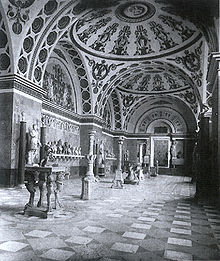Glyptothek

The Glyptothek is a museum in Munich, Germany, which was commissioned by the Bavarian King Ludwig I to house his collection of Greek and Roman sculptures (hence γλυπτο- glypto- "sculpture", from the Greek verb γλύφειν glyphein "to carve"). It was designed by Leo von Klenze in the Neoclassical style, and built from 1816 to 1830. Today the museum is a part of the Kunstareal.
History

The Glyptothek was commissioned by the Crown Prince (later King) Ludwig I of Bavaria alongside other projects, such as the neighboring Königsplatz and the building which houses the State Collection of Greek and Roman Antiquities, as a monument to ancient Greece. He envisioned a "German Athens", in which the ancient Greek culture would be remembered; he had this built in front of the gates of Munich.
The layout of the Königsplatz complex was designed by the architects Karl von Fischer and Leo von Klenze in 1815, the latter arranged it in the style of a forum, with the Glyptothek on the north side. Colorful frescoes and stuccos made by distinguished artists such as Peter von Cornelius, Clemens von Zimmermann, and Wilhelm von Kaulbach adorned the walls of the museum.

In the few years between 1806 and the opening of the museum in 1830, Ludwig completed one of the most magnificent collections of Greek and Roman sculpture. Through his agents, he managed to acquire such pieces as the Medusa Rondanini, the Barberini Faun, and, in 1813, the figures from the Aphaea temple on Aegina.
The Second World War did not destroy much of the artwork in the Glyptothek; but unfortunately the frescoes did not survive and only lightly plastered bricks were visible after the museum was reopened in 1972. Since the Assyrian Hall erected in the inner court by Klenze in 1864 was not rebuilt, the Assyrian Orthostat reliefs from the palace of king Ashur-nasir-pal II and a lion from the Ishtar Gate of Babylon were moved into the Staatliche Sammlung für Ägyptische Kunst.
Architecture
The museum was designed in the Classical Greek - Italian style. The portico is Ionic, and the outer walls contain niches, in which 18 original Roman and Greek sculptures stand, six on each wall (except the back). The interior has domed vaulting.
The museum was originally built completely out of marble. However, during World War II the museum was bombed, and later reconstructed. The walls from the interior are composed of red brick and painted with a light plaster.
Collections
The Glyptothek contains sculptures dating from the archaic age (ca. 650 BC) to the Roman era (ca. 550 AD). Other notable sculptures, mosaics and reliefs can also be found here. This collection is complemented by the terracotta and bronze collections in the Staatliche Antikensammlung (State Collection of Greek and Roman Antiquities), which is located opposite the Glyptothek.


Archaic period (700-490 BC)
Among the most famous sculptures covering this period are the Munich Kouros (statue of an adolescent from Attica, ca 540 BC), the Kouros of Tenea (statue of an adolescent from Corinth, ca 560 BC) and the temple figures from Aegina (510-480 BC). Of the latter, there are in fact two sets of similar sculptures at the Glyptothek. As archeologists excavated the site at Aegina, these two sets were discovered, and it was later theorized that the original temple was destroyed during the Peloponnesian War and another temple was erected shortly after in its place. The Greeks had not bothered to clear the area, and had left the remains of the original temple buried at the same location.
Classical period (490–323 BC)
To the most famous sculptures belong the portrait of Homer (460 BC), the Statue of Diomedes (430 BC), the Medusa Rondanini (440 BC), the Funeral stele of Mnesarete (380 BC), the Statue of Eirene (370 BC), the Alexander Rondanini (ca. 338 BC) and the Ilioneus (ca 320 BC).
Hellenistic period (323–146 BC)
The most famous sculpture representing this time is the Barberini Faun (220 BC). Among the famous Roman copies of Greek sculptures are the Boy with the Goose (ca 250 BC) and the Drunken Woman (attributed to Myron of Thebes; ca 200 BC).
Roman period (150 BC - 550 AD)

The Glyptothek keeps a large collection of Roman busts, among the most famous ones are the busts of the Emperors Augustus (ca 40 AD), Nero (65 AD), Septimius Severus (200 AD) and his wife Julia Domna (195 AD). A heroised statue portrays Domitian as prince (70/80 AD). To the major attractions belong also a colossal statue of Apollo (1st/2nd centuries AD) from a Roman villa in Tuscany, several Roman sarcophagus reliefs and mosaic floors.
